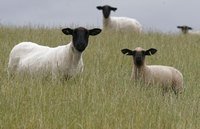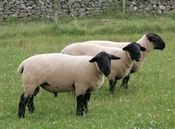Top tups reap rewards

Hardy sheep, bred well and fit to work – that’s what Malcolm Stewart, from Brotherstone, Roxburghshire, aims for as he prepares 150 tups of two breeds for next week’s Kelso tup sales.
But Mr Stewart’s Suffolk and Lleyn rams entered for the sales are not the run of the mill. They are not overfed and pushed for the pedigree market, indeed many traditional flockmasters would, historically, have walked past the pen of Sandyknowe Suffolks to find others with more power and bone.
But times are changing and his brand of Suffolks is coming to the fore as buyers look for well-fleshed, high-indexed sheep rather than big-headed rams with plenty of that unquantifiable trait – character and style. “We’ve been breeding for performance for 30 years and it’s starting to reap rewards.
 “More buyers want estimated breeding values and place their faith in the figures to provide them with the type of tup they know can produce prime lambs that can earn premium prices.”
“More buyers want estimated breeding values and place their faith in the figures to provide them with the type of tup they know can produce prime lambs that can earn premium prices.”
Mr Stewart has invested in the best genetics available, having been a long-term member of the Suffolk Sire Reference Scheme and used high-indexed tups to ensure his female lines are among the best performing in the breed.
This year’s offering of Suffolk shearlings will feature tups with an average index of £3.53, more than £2 up on the flock’s average of 10 years ago. Making lambs sired by an average Sandyknowe tup is worth potentially £2 more than a lamb sired by an average sheep of 1997.
Not that this flock is being bred purely on index. “With a Holstein herd on one of my family’s other farms, I’m aware of what can happen if you concentrate on breeding for one trait too much. Unless you pay attention to the core attributes of what makes a sheep you can quickly lose your way.
“Every ram and ewe has been selected with indexes in mind, but first and foremost they must be well fleshed, good in their legs and mouth and be structurally correct.”
With 400 Suffolk ewes to tup, buying new tups from other flocks is kept to a minimum, and most are selected from homebred lines. “The flock is split into five families, with rams from different families used in rotation. Tups from the first family work in the second, those from the second in the third and so on.”
Tups are bought occasionally, usually when Mr Stewart feels there is a ram available with attributes not offered by a homebred ram lamb.
“Last year I bought a Drinkstone sheep with an exceptional index and he has knitted well with our ewes and has been ranked as the second best stock sire in the breed this time round,” says Mr Stewart.
As commercial flocks are the focus of tup sales, the flock has recently been managed on more commercial lines ewes are lambed inside in April with no concentrate fed after lambing. “The UK sheep industry has to move to grass-based systems. Rising cereal prices are making concentrate feeding uneconomic and labour shortages mean people don’t have time to carry feed to sheep.”
All lambs are recorded at birth for a number of traits, including vigour and their ability to get up and suck. “All replacements have to have lambed themselves and been up and sucking without assistance. Ewes unable to rear their lambs are culled, as are any with bad feet.”
Mr Stewart says years of hard culling for lambing difficulties and milking ability have been hard. “But now the benefits are coming through, for several years ewes were culled heavily, now they lamb easily and milk well off grass.”
Not all the flock is without concentrate feeding. “For the first 20 weeks of their life all lambs are reared purely at grass. Unfortunately, commercial buyers are yet to adjust to purely grass-fed sheep and I have to start feeding tup lambs once the second EBV weighing and ultrasound scanning takes place at 20 weeks.”

At this stage, ram lambs are put on to what Mr Stewart describes as a pedigree ration and fed this through to the end of the following May, when they have a break from feeding until mid-July.
“Ewe lambs, however, receive a little feed after 20 weeks to get them used to the idea of eating concentrate in later life. They are outwintered on kale and stubble turnips alongside the flock ewes, which are brought in for lambing in early-March when they move to hay and a home-mixed concentrate,” says Mr Stewart.
Although most of the selection process to get the flock in its current shape has been based on UK genetics, Mr Stewart has
|
| Both ewes and rams have been selected with figures in mind, but they must be structurally correct as well. |
used some New Zealand bloodlines to gain a shortcut. “Their flocks are well ahead of us, with no concentrate feed and all ewes are lambed outside. That’s where I want to get to and the New Zealand genetics allowed the flock to get closer quicker.”
But UK buyers are not New Zealand buyers, which is why Mr Stewart has to feed tups before sale. “The tups wouldn’t get looked at if they were purely grass fed. If I could sell a lot of tups at home it wouldn’t be such an issue, but most farmers want to buy from a sale, so my tups have to stand up against other flocks.”
Selling Lleyn tups, meanwhile, was largely unplanned, the flock being established with a view of having a commercial flock that could breed its own replacements without the system becoming too complicated.
“Since then, people have asked for tups, so I started selling a few. But breeders need to remember what this breed is: It is a commercial breed not a show sheep and too much interference and feeding could ruin the breed,” he believes.
| KELSO RAM SALES |
|---|
|

